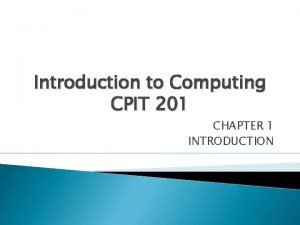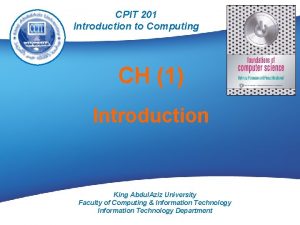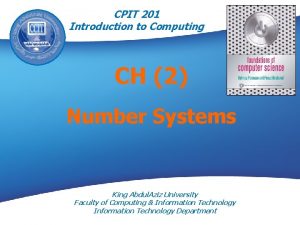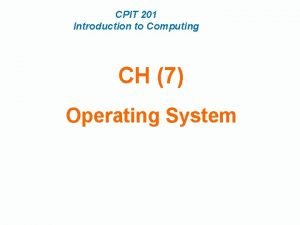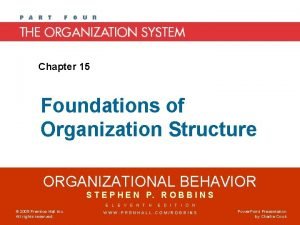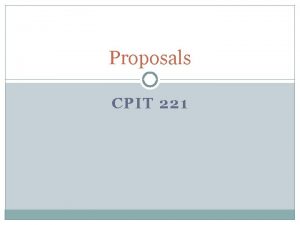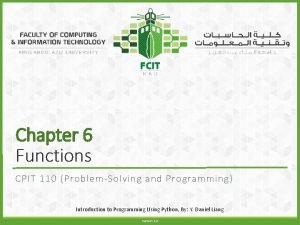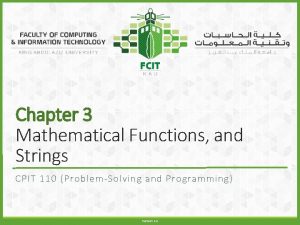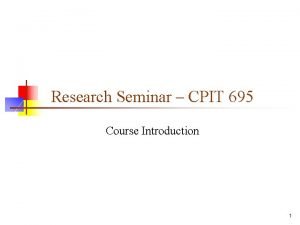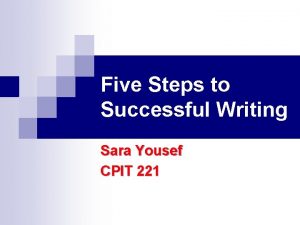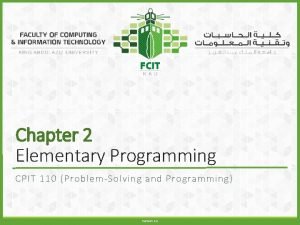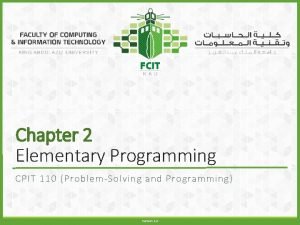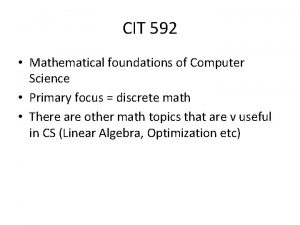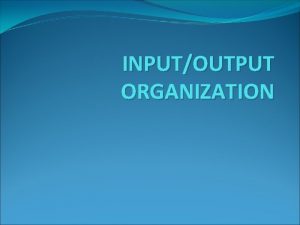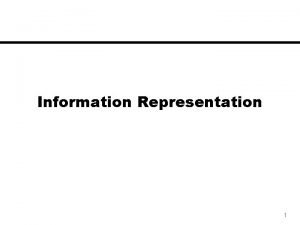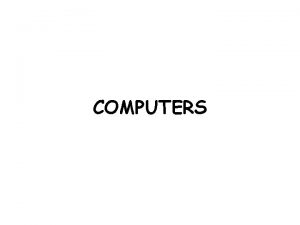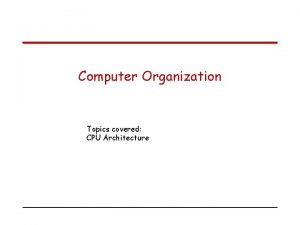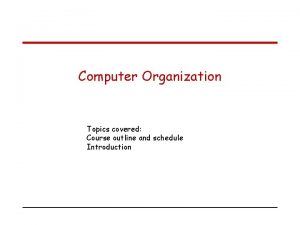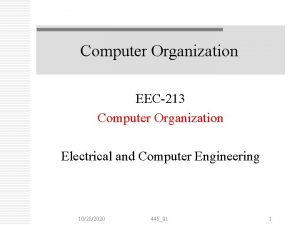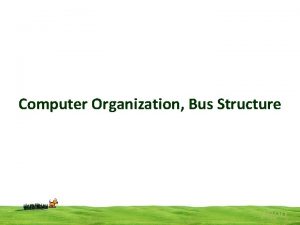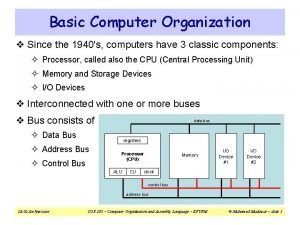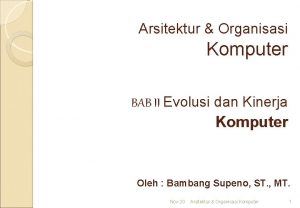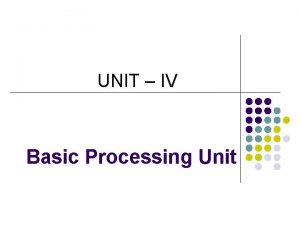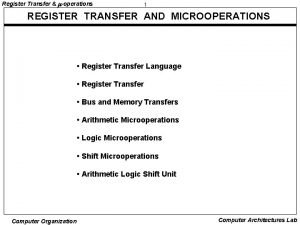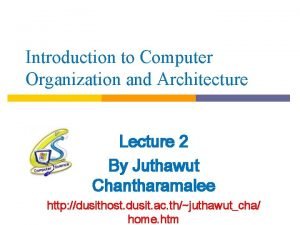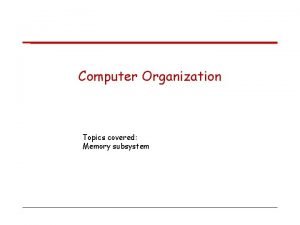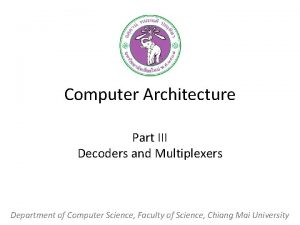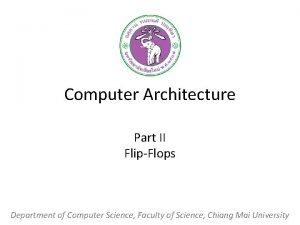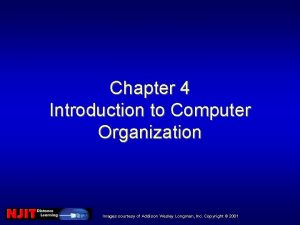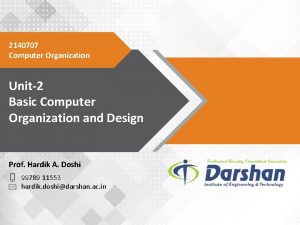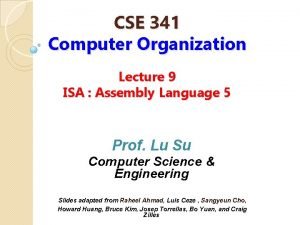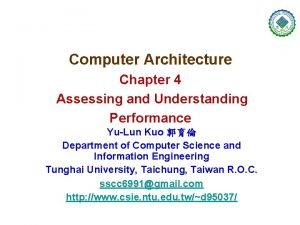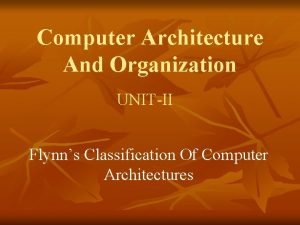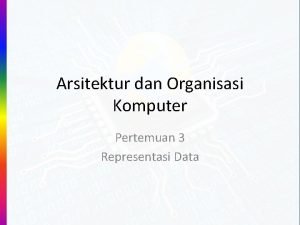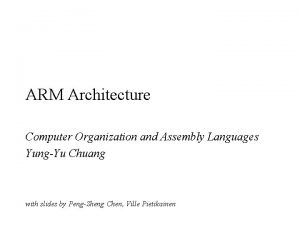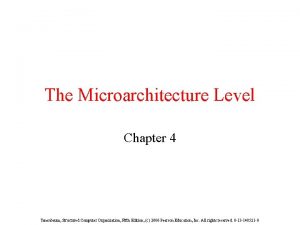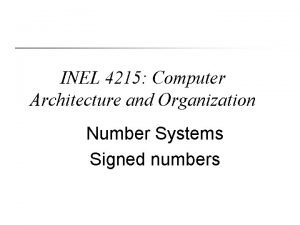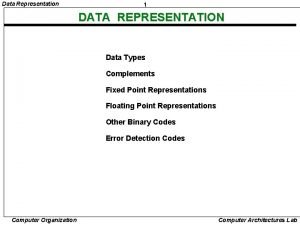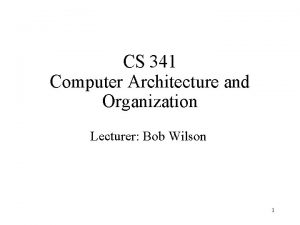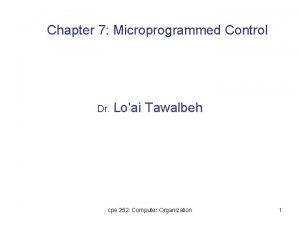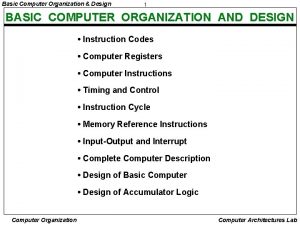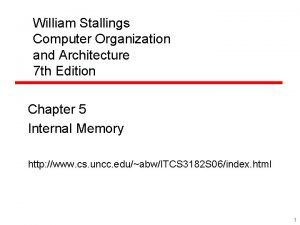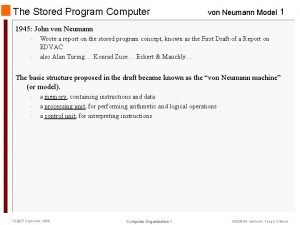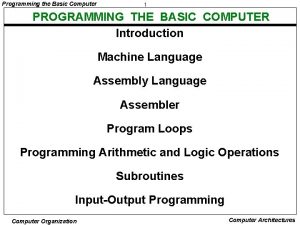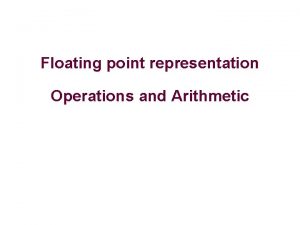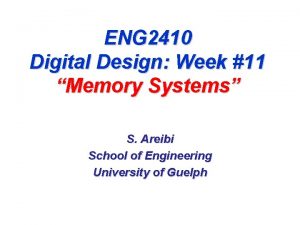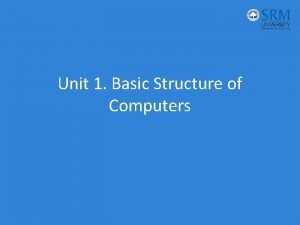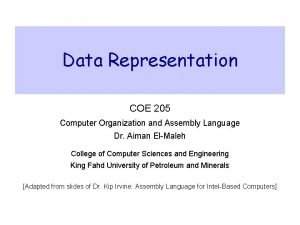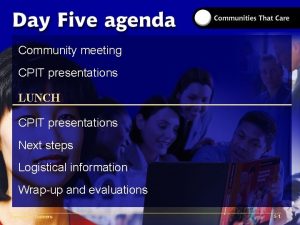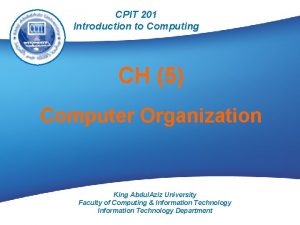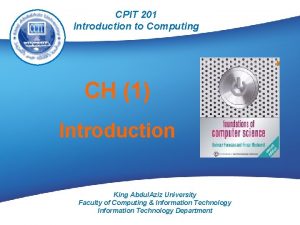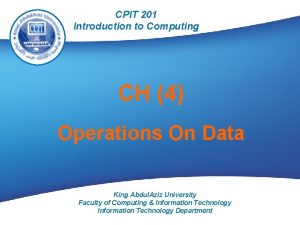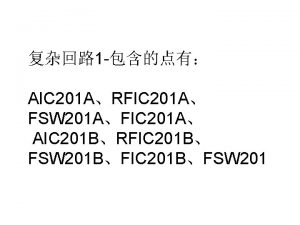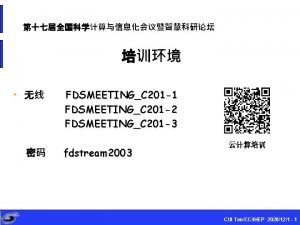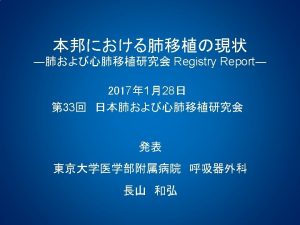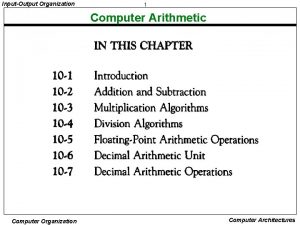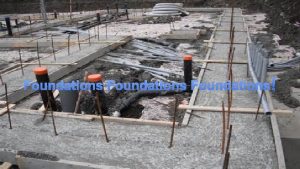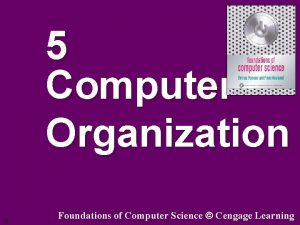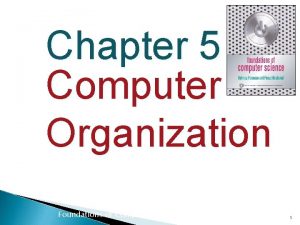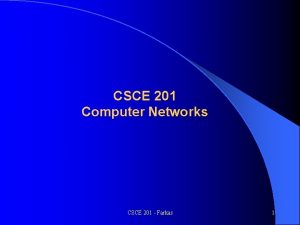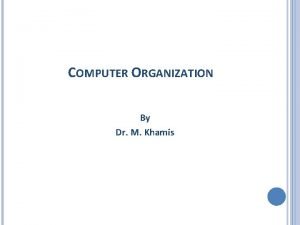5 Computer Organization Foundations 5 1 CPIT 201







































































- Slides: 71

5 Computer Organization Foundations 5. 1 CPIT 201 Learning of Computer Science ã Cengage

Objectives After studying this chapter, the student should be able to: q List the three subsystems of a computer. q Describe the role of the central processing unit (CPU). q Describe the fetch-decode-execute phases of a cycle. q Describe the main memory and its addressing space. q Define the input/output subsystem. q Understand the interconnection of subsystems. q Describe different methods of input/output addressing. q Distinguish the two major trends in the design of computers. q Understand how computer throughput can be improved using pipelining and parallel processing. CPIT 201 5. 2

We can divide the parts that make up a computer into three broad categories or subsystem: the central processing unit (CPU), the main memory and the input/output subsystem. Figure 5. 1 Computer hardware (subsystems)CPIT 5. 3 201

5 -1 CENTRAL PROCESSING UNIT The central processing unit (CPU) performs operations on data. In most architectures it has three parts: an arithmetic logic unit (ALU), a control unit and a set of registers, fast storage locations. 5. 4 CPIT 201

The arithmetic logic unit (ALU) The central processing unit (CPU) performs operations on data. In most architectures it has three parts: an arithmetic logic unit (ALU), a control unit and a set of registers, fast storage locations (Figure 5. 2). 5. Figure 5 5. 2 Central processing unit (CPU) CPIT 201

Registers are fast stand-alone storage locations that hold data temporarily. Multiple registers are needed to facilitate the operation of the CPU. Some of these registers are shown in Figure 5. 2. q Data registers q Instruction register q Program counter 5. 6 CPIT 201

The control unit The third part of any CPU is the control unit. The control unit controls the operation of each subsystem. Controlling is achieved through signals sent from the control unit to other subsystems. 5. 7 CPIT 201

5 -2 MAIN MEMORY Main memory is the second major subsystem in a computer (Figure 5. 3). It consists of a collection of storage locations, each with a unique identifier, called an address. Data is transferred to and from memory in groups of bits called words. A word can be a group of 8 bits, 16 bits, 32 bits or 64 bits (and growing). If the word is 8 bits, it is referred to as a byte. The term “byte” is so common in computer science that sometimes a 16 bit word is referred to as a 2 -byte word, or a 32 -bit word is referred to as a 4 -byte word. 5. 8 CPIT 201

5. 9 Figure 5. 3 Main memory CPIT 201

Address space To access a word in memory requires an identifier. Although programmers use a name to identify a word (or a collection of words), at the hardware level each word is identified by an address. The total number of uniquely identifiable locations in memory is called the address space. For example, a memory with 64 kilobytes and a word size of 1 byte has an address space that ranges from 0 to 65, 535. 5. 10 CPIT 201

i Memory addresses are defined using unsigned binary integers. 5. 11 CPIT 201

Example 5. 1 A computer has 32 MB (megabytes) of memory. How many bits are needed to address any single byte in memory? Solution The memory address space is 32 MB, or 225 (25 × 220). This means that we need log 2 225, or 25 bits, to address each byte. Example 5. 2 A computer has 128 MB of memory. Each word in this computer is eight bytes. How many bits are needed to address any single word in memory? Solution The memory address space is 128 MB, which means 227. However, each word is eight (23) bytes, which means that we have 224 words. This means that we need log 2 224, or 24 bits, to address each word. CPIT 201 5. 12

Memory types Two main types of memory exist: RAM and ROM. Random access memory (RAM) q Static RAM (SRAM) q Dynamic RAM (DRAM) Read-only memory (ROM) q Programmable read-only memory (PROM). q Erasable programmable read-only memory (EPROM). q Electrically erasable programmable read-only memory (EEPROM). 5. 13 CPIT 201

Memory hierarchy Computer users need a lot of memory, especially memory that is very fast and inexpensive. This demand is not always possible to satisfy—very fast memory is usually not cheap. A compromise needs to be made. The solution is hierarchical levels of memory. 5. 14 Figure 5. 4 Memory hierarchy CPIT 201

Cache memory is faster than main memory, but slower than the CPU and its registers. Cache memory, which is normally small in size, is placed between the CPU and main memory (Figure 5. 5). 5. 15 Figure 5. 5 Cache memory CPIT 201

5 -3 INPUT/OUTPUT SUBSYSTEM The third major subsystem in a computer is the collection of devices referred to as the input/output (I/O) subsystem. This subsystem allows a computer to communicate with the outside world and to store programs and data even when the power is off. Input/output devices can be divided into two broad categories: non-storage and storage devices. 5. 16 CPIT 201

Non-storage devices allow the CPU/memory to communicate with the outside world, but they cannot store information. q Keyboard and monitor q Printer 5. 17 CPIT 201

Storage devices, although classified as I/O devices, can store large amounts of information to be retrieved at a later time. They are cheaper than main memory, and their contents are nonvolatile—that is, not erased when the power is turned off. They are sometimes referred to as auxiliary storage devices. We can categorize them as either magnetic or optical. 5. 18 CPIT 201

5. 19 Figure 5. 6 A magnetic disk CPIT 201

5. 20 Figure 5. 7 A magnetic tape CPIT 201

5. 21 CPIT 201 Figure 5. 8 Creation and use of CD-ROMs

5. 22 CPIT 201

Figure 5. 9 CD-ROM format 5. 23 CPIT 201

Figure 5. 10 Making a CD-R 5. 24 CPIT 201

Figure 5. 11 Making a CD-RW 5. 25 CPIT 201

5. 26 CPIT 201

5 -4 SUBSYSTEM INTERCONNECTION The previous sections outlined the characteristics of the three subsystems (CPU, main memory, and I/O) in a stand-alone computer. In this section, we explore how these three subsystems are interconnected. The interconnection plays an important role because information needs to be exchanged between the three subsystems. 5. 27 CPIT 201

Connecting CPU and memory The CPU and memory are normally connected by three groups of connections, each called a bus: data bus, address bus and control bus (Figure 5. 12). Figure 5. 12 Connecting CPU and memory using three buses CPIT 201 5. 28

Connecting I/O devices cannot be connected directly to the buses that connect the CPU and memory, because the nature of I/O devices is different from the nature of CPU and memory. I/O devices are electromechanical, magnetic, or optical devices, whereas the CPU and memory are electronic devices. I/O devices also operate at a much slower speed than the CPU/memory. There is a need for some sort of intermediary to handle this difference. Input/output devices are therefore attached to the buses through input/output controllers or interfaces. There is one specific controller for each input/output device (Figure 5. 13). 5. 29 CPIT 201

Figure 5. 13 Connecting I/O devices to the buses 5. 30 CPIT 201

Figure 5. 14 SCSI controller 5. 31 CPIT 201

Figure 5. 15 Fire. Wire controller 5. 32 CPIT 201

5. 33 Figure 5. 16 USB controller CPIT 201

Addressing input/output devices The CPU usually uses the same bus to read data from or write data to main memory and I/O device. The only difference is the instruction. If the instruction refers to a word in main memory, data transfer is between main memory and the CPU. If the instruction identifies an I/O device, data transfer is between the I/O device and the CPU. There are two methods for handling the addressing of I/O devices: isolated I/O and memory-mapped I/O. 5. 34 CPIT 201

Figure 5. 17 Isolated I/O addressing 5. 35 CPIT 201

Figure 5. 18 Memory-mapped I/O addressing 5. 36 CPIT 201

5 -5 PROGRAM EXECUTION Today, general-purpose computers use a set of instructions called a program to process data. A computer executes the program to create output data from input data. Both the program and the data are stored in memory. i At the end of this chapter we give some examples of how a hypothetical simple computer executes a program. 5. 37 CPIT 201

Machine cycle The CPU uses repeating machine cycles to execute instructions in the program, one by one, from beginning to end. A simplified cycle can consist of three phases: fetch, decode and execute (Figure 5. 19). 5. 38 Figure 5. 19 The steps of a cycle CPIT 201

Input/output operation Commands are required to transfer data from I/O devices to the CPU and memory. Because I/O devices operate at much slower speeds than the CPU, the operation of the CPU must be somehow synchronized with the I/O devices. Three methods have been devised for this synchronization: programmed I/O, interrupt driven I/O, and direct memory access (DMA). q Programmed I/O q Interrupt driven I/O q Direct memory access (DMA 5. 39 CPIT 201

5. 40 Figure 5. 20 Programmed I/O CPIT 201

5. 41 Figure 5. 21 Interrupt-driven I/O CPIT 201

5. 42 Figure 5. 22 DMA connection to the general bus CPIT 201

5. 43 Figure 5. 23 DMA input/output CPIT 201

5 -6 DIFFERENT ARCHITECTURES The architecture and organization of computers has gone through many changes in recent decades. In this section we discuss some common architectures and organization that differ from the simple computer architecture we discussed earlier. 5. 44 CPIT 201

CISC (pronounced sisk) stands for complex instruction set computer (CISC). The strategy behind CISC architectures is to have a large set of instructions, including complex ones. Programming CISC-based computers is easier than in other designs because there is a single instruction for both simple and complex tasks. Programmers, therefore, do not have to write a set of instructions to do a complex task. 5. 45 CPIT 201

RISC (pronounced risk) stands for reduced instruction set computer. The strategy behind RISC architecture is to have a small set of instructions that do a minimum number of simple operations. Complex instructions are simulated using a subset of simple instructions. Programming in RISC is more difficult and time-consuming than in the other design, because most of the complex instructions are simulated using simple instructions. 5. 46 CPIT 201

Pipelining We have learned that a computer uses three phases, fetch, decode and execute, for each instruction. In early computers, these three phases needed to be done in series for each instruction. In other words, instruction n needs to finish all of these phases before the instruction n + 1 can start its own phases. Modern computers use a technique called pipelining to improve throughput (the total number of instructions performed in each period of time). The idea is that if the control unit can do two or three of these phases simultaneously, the next instruction can start before the previous one is finished. 5. 47 CPIT 201

Figure 5. 24 Pipelining 5. 48 CPIT 201

Parallel processing Traditionally a computer had a single control unit, a single arithmetic logic unit and a single memory unit. With the evolution in technology and the drop in the cost of computer hardware, today we can have a single computer with multiple control units, multiple arithmetic logic units and multiple memory units. This idea is referred to as parallel processing. Like pipelining, parallel processing can improve throughput. Figure 5. 24 A taxonomy of computer organization CPIT 201 5. 49

Figure 5. 26 SISD organization 5. 50 CPIT 201

Figure 5. 27 SIMD organization 5. 51 CPIT 201

Figure 5. 28 MISD organization 5. 52 CPIT 201

Figure 5. 29 MIMD organization 5. 53 CPIT 201

5 -7 A SIMPLE COMPUTER To explain the architecture of computers as well as their instruction processing, we introduce a simple (unrealistic) computer, as shown in Figure 5. 30. Our simple computer has three components: CPU, memory and an input/output subsystem. 5. 54 CPIT 201

Figure 5. 30 The components of a simple computer CPIT 5. 55 201

Instruction set Our simple computer is capable of having a set of sixteen instructions, although we are using only fourteen of these instructions. Each computer instruction consists of two parts: the operation code (opcode) and the operand (s). The opcode specifies the type of operation to be performed on the operand (s). Each instruction consists of sixteen bits divided into four 4 -bit fields. The leftmost field contains the opcode and the other three fields contains the operand or address of operand (s), as shown in Figure 5. 31. 5. 56 CPIT 201

Figure 5. 31 Format and different instruction types CPIT 5. 57 201

Processing the instructions Our simple computer, like most computers, uses machine cycles. A cycle is made of three phases: fetch, decode and execute. During the fetch phase, the instruction whose address is determined by the PC is obtained from the memory and loaded into the IR. The PC is then incremented to point to the next instruction. During the decode phase, the instruction in IR is decoded and the required operands are fetched from the register or from memory. During the execute phase, the instruction is executed and the results are placed in the appropriate memory location or the register. Once third phase is completed, the control unit starts the cycle again, but now the PC is pointing to the next instruction. The process continues until the CPU reaches a HALT instruction. 5. 58 CPIT 201

5. 59 CPIT 201

An example Let us show our simple computer can add two integers A and B and create the result as C. We assume that integers are in two’s complement format. Mathematically, we show this operation as: We assume that the first two integers are stored in memory locations (40)16 and (41)16 and the result should be stored in memory location (42)16. To do the simple addition needs five instructions, as shown next: 5. 60 CPIT 201

In the language of our simple computer, these five instructions are encoded as: 5. 61 CPIT 201

Storing program and data We can store the five-line program in memory starting from location (00)16 to (04)16. We already know that the data needs to be stored in memory locations (40)16, (41)16, and (42)16. Cycles Our computer uses one cycle per instruction. If we have a small program with five instructions, we need five cycles. We also know that each cycle is normally made up of three steps: fetch, decode, execute. Assume for the moment that we need to add 161 + 254 = 415. The numbers are shown in memory in hexadecimal is, (00 A 1)16, (00 FE)16, and (019 F)16. 5. 62 CPIT 201

5. 63 Figure 5. 32 Status of cycle 1 CPIT 201

5. 64 Figure 5. 33 Status of cycle 2 CPIT 201

5. 65 Figure 5. 34 Status of cycle 3 CPIT 201

5. 66 Figure 5. 35 Status of cycle 4 CPIT 201

5. 67 Figure 5. 36 Status of cycle 5 CPIT 201

Another example In the previous example we assumed that the two integers to be added were already in memory. We also assume that the result of addition will be held in memory. You may ask how we can store the two integers we want to add in memory, or how we use the result when it is stored in the memory. In a real situation, we enter the first two integers into memory using an input device such as keyboard, and we display the third integer through an output device such as a monitor. Getting data via an input device is normally called a read operation, while sending data to an output device is normally called a write operation. To make our previous program more practical, we need modify it as follows: 5. 68 CPIT 201

In our computer we can simulate read and write operations using the LOAD and STORE instruction. Furthermore, LOAD and STORE read data input to the CPU and write data from the CPU. We need two instructions to read data into memory or write data out of memory. The read operation is: 5. 69 CPIT 201

The write operation is: i The input operation must always read data from an input device into memory: the output operation must always write data from memory to an output device. 5. 70 CPIT 201

The program is coded as: Operations 1 to 4 are for input and operations 9 and 10 are for output. When we run this program, it waits for the user to input two integers on the keyboard and press the enter key. The program then calculates the sum and displays the result on the monitor. 5. 71 CPIT 201
 Cpit 201
Cpit 201 Cpit 201
Cpit 201 Convert from decimal number system to binary digit : 201
Convert from decimal number system to binary digit : 201 Cpit 201
Cpit 201 Process organization in computer organization
Process organization in computer organization Foundation of organizational structure
Foundation of organizational structure Cpit 221
Cpit 221 Cpit221
Cpit221 Cpit 110
Cpit 110 Cpit 110
Cpit 110 Cpit 110
Cpit 110 What is an msc?
What is an msc? Cpit 110
Cpit 110 Cpit 110
Cpit 110 Cpit 110
Cpit 110 Basic structure of a computer
Basic structure of a computer Difference between organisation and architecture
Difference between organisation and architecture Complete computer description in computer organization
Complete computer description in computer organization Fgi and fgo in computer architecture
Fgi and fgo in computer architecture Mathematical foundations of computer graphics and vision
Mathematical foundations of computer graphics and vision Mcit 592
Mcit 592 Point by point arrangement
Point by point arrangement Computer organization and architecture 10th solution
Computer organization and architecture 10th solution Coa virtual lab iit kharagpur
Coa virtual lab iit kharagpur Introduction to computer organization and architecture
Introduction to computer organization and architecture What is nano programming
What is nano programming Bus design in computer architecture
Bus design in computer architecture Accessing io devices
Accessing io devices Computer memory representation
Computer memory representation Basic organization of computer
Basic organization of computer Single bus structure in computer organization
Single bus structure in computer organization Computer organization course
Computer organization course Memory data register
Memory data register Three bus structure in computer organization
Three bus structure in computer organization Spec rating formula in computer organization
Spec rating formula in computer organization Basic computer organization
Basic computer organization Herdaynote arsitektur memori
Herdaynote arsitektur memori Computer organization and architecture 10th edition
Computer organization and architecture 10th edition Wide branch addressing in computer organization
Wide branch addressing in computer organization Register transfer language in computer organization
Register transfer language in computer organization Organisasi komputer
Organisasi komputer Subroutine in computer architecture
Subroutine in computer architecture Semiconductor ram memories in computer organization
Semiconductor ram memories in computer organization What is decoder in computer architecture
What is decoder in computer architecture D flip flop in computer architecture
D flip flop in computer architecture Computer organization images
Computer organization images Interrupt cycle flow chart
Interrupt cycle flow chart Computer arithmetic
Computer arithmetic Computer organization subject code
Computer organization subject code Isa computer organization
Isa computer organization Structured computer organization
Structured computer organization Risc vs cisc example
Risc vs cisc example Microquill
Microquill Flynn's architecture
Flynn's architecture What is computer organization
What is computer organization Data representation in computer organization
Data representation in computer organization Arm in computer organization
Arm in computer organization Computer microarchitecture
Computer microarchitecture 1s complement
1s complement Different types of data representation
Different types of data representation Cs341 umb
Cs341 umb Instruction set architecture in computer organization
Instruction set architecture in computer organization Memory organization in computer architecture
Memory organization in computer architecture Microprogram example
Microprogram example Basic computer design
Basic computer design Advanced dram organization
Advanced dram organization Modello von neumann
Modello von neumann Programming the basic computer
Programming the basic computer Float number
Float number Semiconductor ram memories in computer organization
Semiconductor ram memories in computer organization Basic structure of computers in computer organization
Basic structure of computers in computer organization Hex code ascii
Hex code ascii
